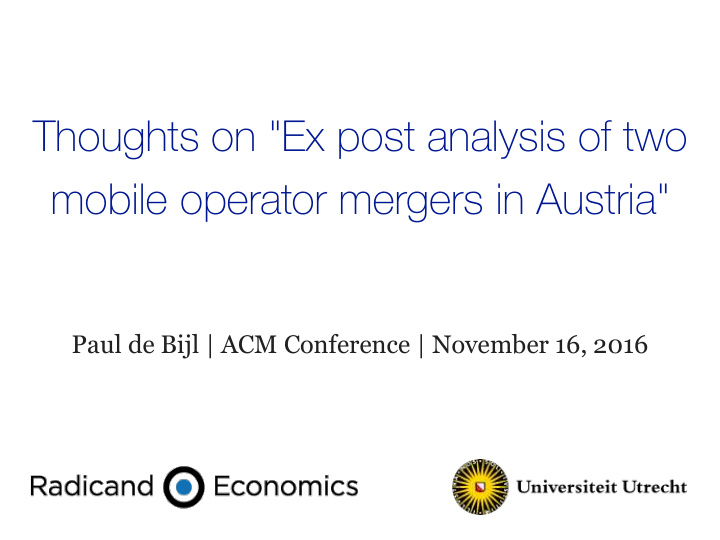



Thoughts on "Ex post analysis of two mobile operator mergers in Austria" Paul de Bijl | ACM Conference | November 16, 2016
The big picture • Consolidation in (and between) fixed telecoms and mobile telecoms markets • natural monopolies… • … in the form of tight oligopolies that are getting even tighter • How to understand the nature of competition in these markets? • What are the implications for competition policy / regulation? 2
Schwarz's contribution (1) • Empirical evaluation of effects on retail prices of two recent mergers in Austria • Several methodological hurdles had to be crossed ‣ measuring price changes over time: different baskets ‣ estimating the impact of merger on prices: 3 approaches 3
Schwarz's contribution (2) • T-Mobile/tele.ring (2006) ‣ 5 to 4 merger ‣ result: asymmetric market shares + remaining maverick ‣ effective remedies ‣ decrease in prices • H3G/Orange (2013) ‣ 4 to 3 merger ‣ result: symmetric market shares, no maverick left ‣ less effective remedies ‣ significant increase in prices 4
Nevertheless • Consumer welfare depends on: ‣ price ‣ quality (download speeds) • What happened to unit prices? ‣ Average revenue/Mb decreased during 2012-2014, at comparable rate as elsewhere in Europe (Frontier Economics, 2015) • Impact of H3G/Orange merger on consumer welfare was not necessarily negative 5
Nature of competition (1) • Price competition with horizontally differentiated goods ‣ partial model, providing a partial view at best ‣ telecommunications services are essentially homogeneous → price discrimination + opaque prices • Large economies of scale / infrastructure investments ‣ do operators pass fixed cost savings on to consumers? ‣ scope for network sharing agreements • In mobile markets, mergers increase prices and levels of investments per operator (Genakos, Valletti and Verboven, 2015) 6
Nature of competition (2) • High rate of technological change ‣ 3G, 4G, 5G ‣ quality and speed, mobile services, F2M convergence, OTT ‣ changing nature of demand and usage patterns • Competition is dynamic ‣ consumers will benefit more from stimulating dynamic efficiency than from protecting static efficiency • Notion of Schumpeterian competition difficult to apply because of spectrum rights (entry barriers) ‣ legal oligopolies 7
• Regulators have been pondering about "3" versus "4", while industry argued in favor of "3"… • … next step may be to claim that "2" works even better 8
Reconciling dynamic competition with risk of too little retail competition: 1. "4" may be safe bet 2. economies of scale → network sharing? 3. voluntary MVNO access — backed by threat of access obligations 4. homogeneity : scrutinize differentiation strategies that make prices opaque (brand differentiation is ok though) 5. homogeneity : net neutrality is crucial 9
Recommend
More recommend